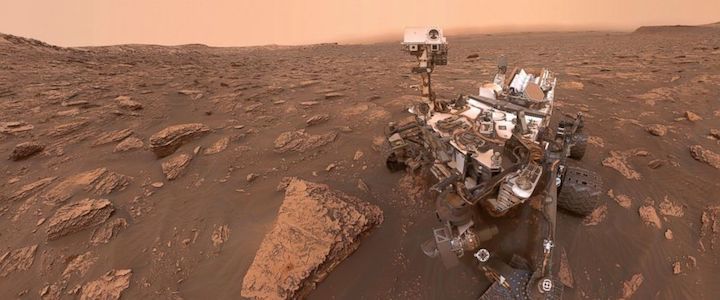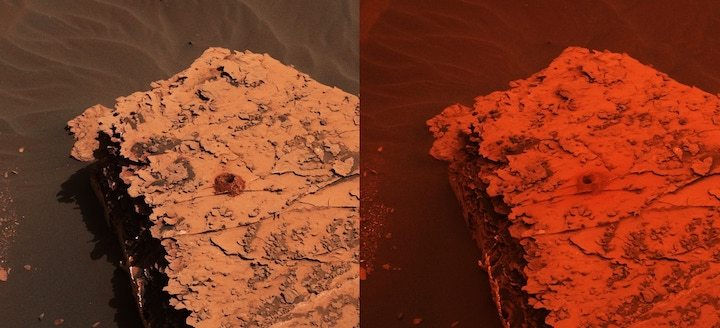15.06.2018
One of the thickest dust storms ever observed on Mars has been spreading for the past week and a half. The storm has caused NASA's Opportunity rover to suspend science operations, but also offers a window for four other spacecraft to learn from the swirling dust.
NASA has three orbiters circling the Red Planet, each equipped with special cameras and other atmospheric instruments. Additionally, NASA's Curiosity rover has begun to see an increase in dust at its location in Gale Crater.
"This is the ideal storm for Mars science," said Jim Watzin, director of NASA's Mars Exploration Program at the agency’s headquarters in Washington. "We have a historic number of spacecraft operating at the Red Planet. Each offers a unique look at how dust storms form and behave -- knowledge that will be essential for future robotic and human missions."
Dusty With a Chance of Dust
Dust storms are a frequent feature on Mars, occurring in all seasons. Occasionally, they can balloon into regional storms in a matter of days, and sometimes even expand until they envelop the planet. These massive, planet-scaled storms are estimated to happen about once every three to four Mars years (six to eight Earth years); the last one was in 2007. They can last weeks, or even months at the longest.
The current storm above Opportunity, which is still growing, now blankets 14 million square miles (35 million square kilometers) of Martian surface -- about a quarter of the planet.
All dust events, regardless of size, help shape the Martian surface. Studying their physics is critical to understanding the ancient and modern Martian climate, said Rich Zurek, chief scientist for the Mars Program Office at NASA's Jet Propulsion Laboratory in Pasadena, California.
"Each observation of these large storms brings us closer to being able to model these events -- and maybe, someday, being able to forecast them," Zurek said. "That would be like forecasting El Niño events on Earth, or the severity of upcoming hurricane seasons."
The thin atmosphere makes these storms vastly different from anything encountered on Earth: Despite the drama of "The Martian," the most powerful surface winds encountered on Mars would not topple a spacecraft, although they can sand-blast dust particles into the atmosphere.
Teamwork
Members of NASA's spacecraft "family" at Mars often help each other out. The agency's orbiters regularly relay data from NASA's rovers back to Earth. Orbiters and rovers also offer different perspectives on Martian terrain, allowing their science to complement one another.
The Mars Reconnaissance Orbiter has a special role, acting as an early warning system for weather events such as the recent storm. It was the orbiter's wide-angle camera, called the Mars Color Imager, that offered the Opportunity team a heads up about the storm. This imager, built and operated by Malin Space Science Systems in San Diego, can create daily global mapsof the planet that track how storms evolve, not unlike weather satellites that track hurricanes here on Earth.
NASA's two other orbiters -- 2001 Mars Odyssey and MAVEN (Mars Atmosphere and Volatile Evolution) -- also provide unique science views. Odyssey has an infrared camera called THEMIS (Thermal Emission Imaging System) that can measure the amount of dust below it; MAVEN is designed to study the behavior of the upper atmosphere and the loss of gas to space.
Science happens on the ground as well, of course. Despite being on the other side of the planet from the evolving dust storm, NASA's Curiosity rover is beginning to detect increased "tau," the measure of the veil of dusty haze that blots out sunlight during a storm. As of Tuesday, June 12, the tau inside Gale Crater was varying between 1.0 and 2.0 -- figures that are average for dust season, though these levels usually show up later in the season.
Fortunately, Curiosity has a nuclear-powered battery. That means it doesn't face the same risk as the solar-powered Opportunity.
The Next Big One?
Since 2007, Mars scientists have been patiently waiting for a planet-encircling dust event -- less precisely called a "global" dust storm, though the storms never truly cover the entire globe of Mars. In 1971, one of these storms came close, leaving just the peaks of Mars' Tharsis volcanoes poking out above the dust.
The most recent dust storm is the earliest ever observed in the northern hemisphere of Mars, said Bruce Cantor of Malin Space Science Systems, deputy principal investigator for the Mars Color Imager. But it could take several more days before anyone can tell whether the storm is encircling the planet.
If it does "go global," the storm will offer a brand new look at Martian weather. Four spacecraft stand ready to collect the science that shakes out.
Fine Print
JPL, a division of Caltech in Pasadena, California, manages the Mars Exploration Rover mission; the Mars Science Laboratory/Curiosity rover; the Mars Reconnaissance Orbiter Project; and the 2001 Mars Odyssey orbiter for NASA's Science Mission Directorate, Washington.
NASA's Goddard Space Flight Center in Greenbelt, Maryland, manages the MAVEN project for NASA's Science Mission Directorate, Washington. MAVEN's principal investigator is based at the University of Colorado Boulder's Laboratory for Atmospheric and Space Physics.
Lockheed Martin Space Systems, Denver, is the prime contractor for the Odyssey, MRO and MAVEN projects, having developed and built all three orbiters. Mission operations are conducted jointly from Lockheed Martin and from JPL for Odyssey and MRO, and jointly with the GSFC for MAVEN.
The Thermal Emission Imaging System (THEMIS) was developed by Arizona State University, Tempe, in collaboration with Raytheon Santa Barbara Remote Sensing. The THEMIS investigation is led by Philip Christensen at Arizona State University.
Quelle: NASA
---
Update: 21.06.2018
.
Mars rover still silent as red planet dust storm goes global

his composite image made from a series of June 15, 2018 photos shows a self-portrait of NASA's Curiosity Mars rover in the Gale Crater. The rover's arm which held the camera was positioned out of each of the dozens of shots which make up the mosaic. A dust storm has reduced sunlight and visibility at the rover's location. (NASA/JPL-Caltech via AP)
.
A dust storm at Mars is now global, keeping NASA's Opportunity rover out of touch with Earth.
Flight controllers lost contact with the rover more than a week ago. At the time, the dust storm covered one-fourth of Mars. NASA said Wednesday the storm now encircles the red planet, with only tall volcano peaks and the poles exposed to the sun.
Without sunlight, the solar-powered Opportunity can only hunker down and wait for the sky to clear.
NASA's nuclear-powered rover Curiosity is unaffected and is studying the extreme weather conditions. Mars hasn't seen a storm like this since 2007.
Scientists at NASA's Jet Propulsion Laboratory in Pasadena, California, say they remain optimistic Opportunity can survive. The rover has been exploring Mars since 2004.
Quelle: abcNews
+++
Martian Dust Storm Grows Global; Curiosity Captures Photos of Thickening Haze

Two images from the Mast Camera (Mastcam) on NASA's Curiosity rover depicting atmospheric changes since a dust storm descended on Gale Crater. The left image shows the "Duluth" drill site on Sol 2058 (May 21); the right image is from Sol 2084 (June 17). Both images have been white balanced and contrast-enhanced. Image Credit: NASA/JPL-Caltech/MSSS
-
A storm of tiny dust particles has engulfed much of Mars over the last two weeks and prompted NASA's Opportunity rover to suspend science operations. But across the planet, NASA's Curiosity rover, which has been studying Martian soil at Gale Crater, is expected to remain largely unaffected by the dust. While Opportunity is powered by sunlight, which is blotted out by dust at its current location, Curiosity has a nuclear-powered battery that runs day and night.
The Martian dust storm has grown in size and is now officially a "planet-encircling" (or "global") dust event.
Though Curiosity is on the other side of Mars from Opportunity, dust has steadily increased over it, more than doubling over the weekend. The sunlight-blocking haze, called "tau," is now above 8.0 at Gale Crater -- the highest tau the mission has ever recorded. Tau was last measured near 11 over Opportunity, thick enough that accurate measurements are no longer possible for Mars' oldest active rover.
For NASA's human scientists watching from the ground, Curiosity offers an unprecedented window to answer some questions. One of the biggest is: why do some Martian dust storms last for months and grow massive, while others stay small and last only a week?
"We don't have any good idea," says Scott D. Guzewich, an atmospheric scientist at NASA Goddard Space Flight Center in Greenbelt, Maryland, leading Curiosity's dust storm investigation.
Curiosity, he points out, plus a fleet of spacecraft in the orbit of Mars, will allow scientists for the first time to collect a wealth of dust information both from the surface and from space. The last storm of global magnitude that enveloped Mars was in 2007, five years before Curiosity landed there.
In the animation above, Curiosity is facing the crater rim, about 18.6 miles (30 kilometers) away from where it stands inside the crater. Daily photos captured by its Mast Camera, or Mastcam, show the sky getting hazier. This sun-obstructing wall of haze isabout six to eight times thicker than normal for this time of season.
Curiosity's engineers at NASA's Jet Propulsion Laboratory in Pasadena, California, have studied the potential for the growing dust storm to affect the rover's instruments, and say it poses little risk. The largest impact is to the rover's cameras, which require extra exposure time due to the low lighting. The rover already routinely points its Mastcam down at the ground after each use to reduce the amount of dust blowing at its optics. JPL leads the Mars Science Laboratory/Curiosity mission.
Martian dust storms are common, especially during southern hemisphere spring and summer, when the planet is closest to the Sun. As the atmosphere warms, winds generated by larger contrasts in surface temperature at different locations mobilize dust particles the size of individual talcum powder grains. Carbon dioxide frozen on the winter polar cap evaporates, thickening the atmosphere and increasing the surface pressure. This enhances the process by helping suspend the dust particles in the air. In some cases, the dust clouds reach up to 40 miles (60 kilometers) or more in elevation.
Though they are common, Martian dust storms typically stay contained to a local area. By contrast, the current storm, if it were happening on Earth, is bigger than North America and Russia combined, says Guzewich.
The dust storm may seem exotic to some Earthlings, but it's not unique to Mars. Earth has dust storms, too, in desert regions such as NorthAfrica, the Middle East, and the southwest United States.
But conditions here prevent them from spreading globally, said Ralph A. Kahn, a Goddard senior research scientist who studies the atmospheres of Earth and Mars. These include the structure of our thicker atmosphere and stronger gravity that helps settle dust. Earth also has vegetation cover on land that binds the soil with its roots and helps block the wind and rain that wash the particles out of the atmosphere.
Quelle: NASA





